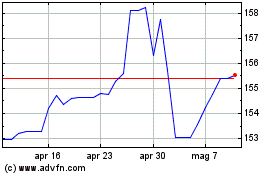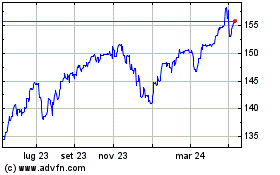Dollar Falls As U.S. Job Growth Slows More Than Forecast
03 Novembre 2017 - 10:51AM
RTTF2
The U.S. dollar weakened against its major opponents in the
European session on Friday, as a data showed that the economy
created less jobs than forecast in October.
Data from the Labor Department showed that the employment rose
by 261,000 jobs in October. This follows a revised increase of
18,000 jobs in September, which was originally reported as a
decline of 33,000 jobs.
Economists had expected the employment to rise by 313,000
jobs.
The jobless rate fell to 4.1 percent from 4.2 percent in the
previous month. The unemployment rate had been expected to remain
unchanged from the last month.
Separate data from the same agency showed that the U.S. trade
deficit largely matched economists' expectations in September. The
deficit widened to $43.5 billion in September from a revised $42.8
billion in August. Economists had been calling for a deficit of
$43.2 billion. Meanwhile, investors assessed details of the GOP tax
reform bill introduced on Thursday.
The proposal lowers corporate tax rate to 20 percent from 35
percent.
For individuals, the plan reduces the number of tax brackets to
four, with tax rates of 12 percent, 25 percent, 35 percent and 39.9
percent.
The tax bill is estimated to increase the debt by $1.5 trillion
over the next decade.
The currency has been trading in a negative territory in the
Asian session, with the exception of the euro. The greenback
declined to 1.3131 against the pound, after having advanced to a
4-week high of 1.3040 at 4:15 am ET. Continuation of the
greenback's downtrend may see it challenging support around the
1.33 area.
Survey data from IHS Markit showed that the UK service sector
expanded at the strongest pace in six months in October.
The IHS Markit/Chartered Institute of Procurement & Supply
Purchasing Managers' Index rose unexpectedly to 55.6 in October
from 53.6 in September. The reading was expected to drop to
53.3.
The greenback reversed from an early high of 1.0002 against the
franc, sliding to a 3-day low of 0.9948. The greenback is seen
finding support around the 0.98 mark.
Data from the UBS investment bank showed that the Swiss real
estate bubble index remained in the risk zone in the third
quarter.
The UBS Swiss Real Estate Bubble Index fell to 1.38 in the third
quarter from revised 1.41 in the previous quarter.
The greenback hit 1.1690 against the euro, its weakest since
October 26. This may be compared to a high of 1.1639 hit at 7:30 am
ET. If the greenback extends decline, 1.18 is likely seen as its
next support level.
Having advanced to 114.15 against the yen at 5:45 am ET, the
greenback reversed direction and weakened to 113.64. The greenback
is poised to challenge support around the 113.00 mark.
The greenback eased back to 0.7694 against the aussie, from its
early 2-day high of 0.7662. Against the kiwi, the currency hovered
at an early 10-day low of 0.6950, down from its previous high of
0.6907. Next likely support for the greenback is seen around 0.775
against the aussie and 0.71 against the kiwi.
The greenback dropped to a 9-day low of 1.2715 versus the
loonie, from a high of 1.2835 hit at 5:45 am ET. Further downtrend
may take the greenback to a support around the 1.26 mark.
U.S. ISM non-manufacturing index for October and factory orders
for September are set for release shortly.
At 12:15 pm ET, Minneapolis Fed President Neel Kashkari speaks
about monetary policy and the 2018 outlook at the Women in Housing
and Finance luncheon, in Washington DC.
Grafico Cross US Dollar vs Yen (FX:USDJPY)
Da Mar 2024 a Apr 2024

Grafico Cross US Dollar vs Yen (FX:USDJPY)
Da Apr 2023 a Apr 2024
